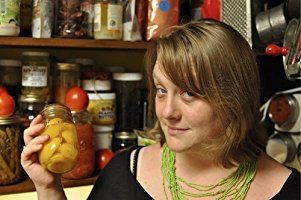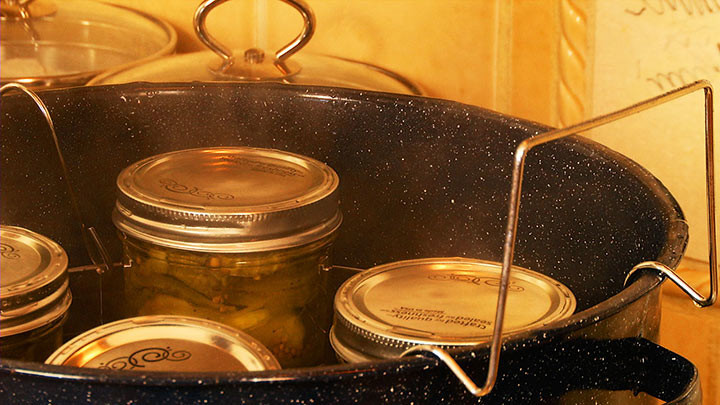It all happens in Marisa McClellan’s tiny kitchen
By Sabrina Emms
She may can in her grandmother’s kitchen but she isn’t making her grandmother’s jam. Armed with a potato masher and a worn wooden spoon, Marisa McClellan is a kitchen revolutionary.
McClellan wants to lead city folk back to their tiny kitchens, and, on those modern hearths, breathe life back into the art of canning.
Like other DIY pursuits, canning may be making a comeback. McClellan, through her blog and then her books, has had quite a bit of influence on the Philadelphia canning scene. She is using this influence to encourage adventurous, brave canning, for everyone from beginners to experts like herself.

—- Marisa McClellan
In her Amazon author’s profile McClellan looks more scrap booker than rabble-rouser, in her late 30s, with shoulder-length blond hair, and a large, bright, necklace. She looks far too young for old school canning’s target demographic. On the surface, her books promise to teach people to make their own delicious seasonal jams. Her deeper mission is to demystify the production of canned goods, encouraging people to forgo store bought and make their own. She doesn’t sell her jams, jellies, preserves or chutneys,
“Urban canning”, is what McClellan calls it in her books and on her popular blog, Food in Jars. “Up until recently all canning recipes were written for people who were canning in order to have enough food to make it through the winter.” McClellan explained to Mother Nature Network an online new source. Her passion — small batch urban canning — liberates canning from its previous function. Preservation brought McClellan back to canning but her blog has taken spectacular leaps from there. Already a food writer when she started Food in Jars in 2009, McClellan paired innovative, often beautifully colored combinations, with easy instructions and charming anecdotal writing. Soon, gleaming jewel-tone jars filled her shelves and food writing flowed with the ease of a natural talent. “Writing about food felt the most natural, an abundant and juicy area,” she explained.
McClellan isn’t just about unique or intriguing flavors, she also wants to share the joy and satisfaction of canning, and to extinguish some of the fears. “Hear me now. If you stick to the high-acid foods—most jams, fruit butters, and pickles—you are not going to kill anyone,” she writes in her third book, “Naturally Sweetened Food in Jars”. McClellan tells new canners that while there are real dangers in canning, like botulism, the acidity in jams blocks the growth of the botulinum bacteria.
The environment, not within the jams, but on Pacific coast, may have helped McClellan get where she is today. She was raised by a, “hippie mom” in her words, who was a causal, almost instinctive, canner. McClellan reminisced about her mom’s raisin concentrates and syrups to Margaret Roach, a former editorial director for Martha Stewart in an interview for Roach’s blog, A Way to Garden. Despite her Portlandian upbringing McClellan’s people have been Philadelphians for generations and when she inherited her grandmother’s apartment, she moved and became part of the Philadelphia food scene.
The Pacific Northwest may boast the abundance of apples and blackberries McClellan remembers, but Pennsylvania is no slouch in the produce department and so many recipes still begin from some kind of abundance. McClellan cans seasonally, and so she is partially constrained by what is growing. Now is the right time for apple and pear based jams or compotes, possibly with ginger or cranberries.
When you are a popular urban canning pioneer, with legions of eager followers, foods find a way to your door, and new concoctions arise, like when strawberry grower Driscoll’s sent her a large box of strawberries, and she whipped up a Strawberry Lavender Caramel.
McClellan doesn’t can in a vacuum; she isn’t immune from the pressures of the world of food. Often the taste du jour makes its way into her pot. In 2015 it was, “Small Batch Strawberry Balsamic Jam”. In 2012 it was “Orange Tomato Jam with Smoked Paprika.” Sometimes the combinations are off the wall, like Peach Oolong Jelly, on her blog, or an apricot-barbecue sauce with gochujang, a spice Korean condiment, a recipe found in her “Naturally Sweet Food in Jars”.
McClellan is not one to shy away from the new. “I love the fact that as a country our palate is expanding,” she said. And it makes sense, new flavors offer new avenues of discovery. Of her pickled blueberries, she writes on her blog, “When I first started pickling fruit four or five years ago, I experienced a lot of resistance.” But now, she loves the expanding tolerance to, as she calls them, funky fermented flavors. “I remember 10 or 12 years ago, no one had heard of kombucha, now you can buy it at Target.”
Clearly the food world, and the Philadelphian food scene are expanding. Gone are the days when the Philadelphia food scene was small enough McClellan felt she could “have her whole arms wrapped around it”. While she likes the changes, McClellan does wish that trends would slow down a bit, to let her really engage with the flavors a little longer.
Canning, something born out of necessity, has morphed into a stand-in for authenticity, for wanting a personal stake in the food we eat. The Food in Jar’s kitchen may be old — this is McClellan’s fifteenth year there — but the flavors are new, and the pots on the stove are always bubbling. Few grandmothers are likely to have made the Cantaloupe Jam with Vanilla that appears in, “Food in Jars”, but they would recognize the creativity, love and effort, all mixed with just a touch of nostalgia, that go into McClellan’s work.
